USGS Partners with University of Alabama to Build Hydrologic Instrumentation Facility
The U.S. Geological Survey is partnering with the University of Alabama to construct a new Hydrologic Instrumentation Facility, a science and engineering facility that will support the agency’s Water Enterprise observing networks and research.
Built on the northern end of campus, the HIF will support training, repairs and calibration for hydrological equipment that monitors streamflow, groundwater, water quality and other water resource features important to all Americans who rely on water. The HIF will support the greater USGS water-resource monitoring and evaluation mission with training and equipment necessary for the comprehensive scientific study of water availability, quality and quantity. USGS expects the facility will support and encourage strong collaboration with other federal agencies located on campus.
“This partnership will ensure a world-class USGS facility for the testing and development of cutting edge USGS hydrologic instrumentation, which provides the backbone for our near-real time water monitoring and other research,” said Don Cline, Associate Director for the USGS Water Mission Area. “This information enriches the lives of everyday Americans and is used nationwide by all types of end users, from water managers to recreational boaters, to make critical decisions.”
Recognizing the need to replace the current facilities located at the National Aeronautics and Space Administration Stennis Space Center in Bay St. Louis, Mississippi, Congress appropriated $38.5 million to replace the aging buildings with the requirement to collocate with complementary academic and federal partners. UA was selected as the site of the new HIF for the opportunities it provided to dovetail with other water-related research and development being conducted on campus, including the NOAA National Water Center.
The 95,000 square feet, two story facility will include a hydraulics lab, water quality labs, field testing facilities, environmental chambers, sensor innovation space, warehouse, training labs, network operations center and administrative offices. Unique features of the hydraulics lab will include a tilting flume and test basin for simulating river and stream processes and a 350-foot-long tow tank and carriage, which will provide a national water velocity standard for calibrating field instrumentation.
Construction is expected to begin in early 2022, and the USGS plans to take occupancy in 2023.
